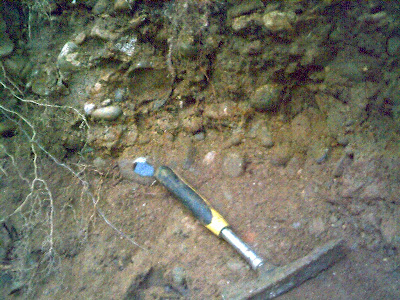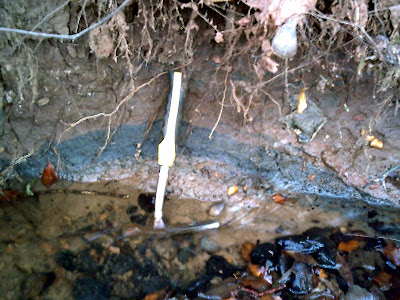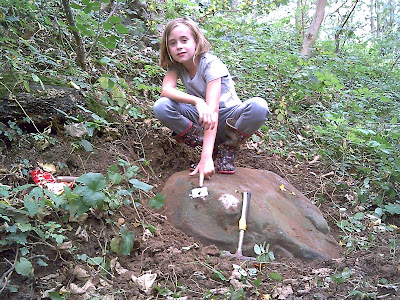Saturday, 15 October 2011
New deposits uncovered shrouding the Stainton gravel beds.
Location:Cleveland England
Stainton, Middlesbrough, UK
Friday, 14 October 2011
More Andesite (whinstone) that atracts a magnet
 I discovered this whinstone today it has been used as a bridge in two locations over a drainage channel just south of the larchfield community, there's a 16 inch pipe under the stone so i imagine it was done in the early to mid 20th century, probably with left over mined whinstone from the Stainton area.
I discovered this whinstone today it has been used as a bridge in two locations over a drainage channel just south of the larchfield community, there's a 16 inch pipe under the stone so i imagine it was done in the early to mid 20th century, probably with left over mined whinstone from the Stainton area.All the stone in the image attracted the magnet shown stuck to the whinstone block above the pipe.
Location:Cleveland England
Stainton, Middlesbrough, UK
Excavations.
This post is to reassure any groups or individuals who come across my blog that there is no lasting damage to the becks and no wildlife is ever disturbed. If there are signs of life ie Voles or even rats the area gets left alone.
As for the becks themselves any excavations are out of sight, and done in such a manor that the natural flooding of the beck will restore any area back as it was, in the main i choose areas that have recently collapsed naturally therefore not changing the natural course of the becks.
One thing i have noticed that may be of interest to people involved with the wildlife of the becks is wherever i see these ancient deposits exposed, ie the river gravels clays some laminated some not, Voles and other small mammals have had no interest in digging into now or in the past, the material is probably to tough to get through.
As for the becks themselves any excavations are out of sight, and done in such a manor that the natural flooding of the beck will restore any area back as it was, in the main i choose areas that have recently collapsed naturally therefore not changing the natural course of the becks.
One thing i have noticed that may be of interest to people involved with the wildlife of the becks is wherever i see these ancient deposits exposed, ie the river gravels clays some laminated some not, Voles and other small mammals have had no interest in digging into now or in the past, the material is probably to tough to get through.
Tuesday, 11 October 2011
Whinstone in Ormesby beck
I have discovered today that like Stainton, Maltby, and Marton west beck, Ormesby beck has an abundance of whinstone both in the beck and in the same buried packed gravel layer as found at all the other becks.
 The image above shows one of the many pieces of whinstone in the packed gravel layer, and as with Stainton all pieces checked attracted a magnet.
The image above shows one of the many pieces of whinstone in the packed gravel layer, and as with Stainton all pieces checked attracted a magnet.
 Naturally exposed red clay layer Ormesby beck in this area seems more advanced in the processes of cutting through the red clay layer than the other becks.
Naturally exposed red clay layer Ormesby beck in this area seems more advanced in the processes of cutting through the red clay layer than the other becks.
 More Whinstone i would say Whinstone is by far the most abundant rock in this stretch of Ormesby beck, and all tested attracted a magnet.
More Whinstone i would say Whinstone is by far the most abundant rock in this stretch of Ormesby beck, and all tested attracted a magnet.
This is the biggest whinstone boulder ive come across at any location so far, it also attracted a magnet.
 The hammer sits on the red clay layer then the gravel layer then the blue gray layer that contains the organic material then the sandy deposits.
The hammer sits on the red clay layer then the gravel layer then the blue gray layer that contains the organic material then the sandy deposits.
 I am starting to believe all the similar exposed layers in the deepest parts of all five becks are connected ie the same event caused the sequence of deposits in all the becks.
I am starting to believe all the similar exposed layers in the deepest parts of all five becks are connected ie the same event caused the sequence of deposits in all the becks.
 The image above shows one of the many pieces of whinstone in the packed gravel layer, and as with Stainton all pieces checked attracted a magnet.
The image above shows one of the many pieces of whinstone in the packed gravel layer, and as with Stainton all pieces checked attracted a magnet.These images show the gravel layer with the red clay layer below again the same as found at Stainton, Maltby, Marton west beck, and Stainsby beck.

 Naturally exposed red clay layer Ormesby beck in this area seems more advanced in the processes of cutting through the red clay layer than the other becks.
Naturally exposed red clay layer Ormesby beck in this area seems more advanced in the processes of cutting through the red clay layer than the other becks. More Whinstone i would say Whinstone is by far the most abundant rock in this stretch of Ormesby beck, and all tested attracted a magnet.
More Whinstone i would say Whinstone is by far the most abundant rock in this stretch of Ormesby beck, and all tested attracted a magnet.These pics show a natural exposure of the gravel layer with the red clay below, and at least two other deposits above the gravels very much like my main dig at Stainton.

This is the biggest whinstone boulder ive come across at any location so far, it also attracted a magnet.
 The hammer sits on the red clay layer then the gravel layer then the blue gray layer that contains the organic material then the sandy deposits.
The hammer sits on the red clay layer then the gravel layer then the blue gray layer that contains the organic material then the sandy deposits.The gravel layer is very like that at Stainton in having finer orange gravels to the bottom containing organic material

 I am starting to believe all the similar exposed layers in the deepest parts of all five becks are connected ie the same event caused the sequence of deposits in all the becks.
I am starting to believe all the similar exposed layers in the deepest parts of all five becks are connected ie the same event caused the sequence of deposits in all the becks.The only possible way i can think of that deposited this whinstone here and in the other deep beck valley locations is ice, yet i can not explain the uniformed layers theres nothing erratic about these deposits in any of the locations, with the added complication of the organic material in the lower packed fine gravels at Stainton and Ormesby becks uncovered so far ! 

Location:Cleveland England
Middlesbrough, UK
Friday, 7 October 2011
Magnetic whinstone of Marton west beck ( Stainton gravel beds )
Every whinstone boulder i checked attracted a magnet, this stretch of Marton west beck has a very large amount of whinstone of all sizes, all seem to be water worn, and all the Andesite (whinstone) i tested was magnetic.
 I presume these magnetic Andesite boulders were originally part of the dyke in the Stainton area and were broken away by the last ice advance.
I presume these magnetic Andesite boulders were originally part of the dyke in the Stainton area and were broken away by the last ice advance.Ime not sure what rock this is yet, but it came from the same gravel layer as the magnetic Andesite (whinstone)
 This stretch of Marton west beck has by far the largest deposits of Andesite dyke stone i have found anywhere in the south Cleveland area, the gravel layers in the beck banks are full of it, and all tested were magnetic.
This stretch of Marton west beck has by far the largest deposits of Andesite dyke stone i have found anywhere in the south Cleveland area, the gravel layers in the beck banks are full of it, and all tested were magnetic.
These images show what i believe is the same red clay ive found underlying everything in the south west Middlesbrough area, with the gravel layer above.

The image below hopefully shows the amount of material above these layers, i would say at least a 35 metres

 These images show the blue clay seem that ive also found in the red clay layer at Stainton, Maltby, and, Ormesby becks.
These images show the blue clay seem that ive also found in the red clay layer at Stainton, Maltby, and, Ormesby becks. Red clay layer with gravel layer above, again the same as seen at Stainton, Maltby, and ormesby becks.
Red clay layer with gravel layer above, again the same as seen at Stainton, Maltby, and ormesby becks.
Location:Cleveland England
Middlesbrough, UK
Monday, 3 October 2011
Magnetic whinstone boulder from Stainton gravel beds.
These images show my daughter pointing out the small magnet stuck to this worn whinstone boulder.
 The boulder seems to be water worn
The boulder seems to be water worn
New mineralised bone finds Stainsby beck
The magnetic properties of the Cleveland dyke in t...
The boulder is buried into the bank of Stainton beck.
The boulder is extremely tough i could not crack a piece off, but exposed enough fresh surface to be able to see it is Whinstone.
I placed the magnet over a thin piece of paper to make sure nothing was helping the magnet stick.
 The boulder seems to be water worn
The boulder seems to be water wornNew mineralised bone finds Stainsby beck
The magnetic properties of the Cleveland dyke in t...
Location:Cleveland England
Stainton, Middlesbrough, UK
Sunday, 25 September 2011
Magnetic Whinstone of Stainton beck Middlesbrough.
This shows that even the boulder sized Whinstone from these released ancient river gravels are magnetic, i can not find any reference that states or shows images of the magnetic attraction of kind ive shown here.
The biggest piece of magnetic Whinstone is about 4ft by 3ft most of the rocks in the pic are magnetic, the magnet used is very small so Ive placed a thin piece of paper to hopefully highlight it, and to create a smooth surface to make sure nothing was helping the magnet to stick.
I dug a leg bone out from under this magnetic Whinstone.
The magnetic properties of the Cleveland dyke in t...
The biggest piece of magnetic Whinstone is about 4ft by 3ft most of the rocks in the pic are magnetic, the magnet used is very small so Ive placed a thin piece of paper to hopefully highlight it, and to create a smooth surface to make sure nothing was helping the magnet to stick.
I dug a leg bone out from under this magnetic Whinstone.
The magnetic properties of the Cleveland dyke in t...
Location:Cleveland England
Stainton, Middlesbrough, Cleveland, UK
Subscribe to:
Comments (Atom)

































